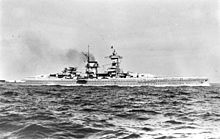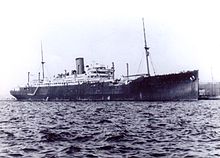Convoy HX 84
The convoy HX 84 was an allied convoy of the HX convoy series to supply Great Britain during World War II . He left Halifax, Canada on October 28, 1940 and was supposed to go to Liverpool . The Allies lost five cargo ships with 33,628 GRT to the German heavy cruiser Admiral Scheer , while there were no losses on the German side. This made the HX 84 one of the most lossy HX convoys.
Composition and securing
The convoy HX 84 consisted of 38 cargo ships. On October 28, 1940, they left Halifax ( Lage ) for Liverpool ( Lage ). The convoy commodore was Rear Adm. Henry Bradford Maltby , who had embarked on the Cornish City . On departure, the Canadian destroyers St. Francis and Columbia took over the protection of the convoy together with the British auxiliary cruiser Jervis Bay . After two days, the two destroyers left the escort as planned, so that only Jervis Bay was available as security for the Atlantic crossing .
| Surname | flag | Measurement in GRT | Whereabouts |
|---|---|---|---|
| Andalusian |
|
3,082 | Damaged by Admiral Scheer on November 5th |
| Anna Bulgaris |
|
4,603 | |
| Athelempress |
|
8,941 | |
| Atheltemplar |
|
8,992 | |
| Beaverford |
|
10,042 | sunk by Admiral Scheer on November 5th ( location ) |
| Briarwood |
|
4.019 | |
| Castilian |
|
3,076 | |
| Cetus |
|
2,614 | |
| Cordelia |
|
8,190 | |
| Cornish City |
|
4,952 | |
| Dan Y Bryn |
|
5.117 | |
| Danae II |
|
2,660 | |
| Delphi |
|
4,571 | |
| Delphinula |
|
8,120 | |
| Emile Franqui |
|
5,859 | |
| Empire Penguin |
|
6,389 | |
| Frodona |
|
6,207 | |
| Fresno City |
|
4,955 | sunk by the Admiral Scheer on November 5th |
| Hjalmar Wessel |
|
1,742 | |
| James J Maguire |
|
10,525 | |
| Kenbane Head |
|
5,225 | sunk by Admiral Scheer on November 5th ( location ) |
| Lancaster Castle |
|
5,172 | |
| Maiden |
|
7,908 | sunk by Admiral Scheer on November 5th ( location ) |
| Morska Wolan |
|
3,208 | |
| Oilreliance |
|
5,666 | |
| Pacific Enterprise |
|
6,736 | |
| Persian |
|
5,382 | |
| puck |
|
1,065 | |
| Rangitiki |
|
16,698 | |
| Saint Gobain |
|
9,959 | |
| San Demetrio |
|
8,073 | damaged by Admiral Scheer on November 5th ( location ) |
| Solfonn |
|
9,925 | |
| Sovac |
|
6,724 | |
| Stern bar |
|
4,575 | |
| Trefusis |
|
5,299 | |
| Trewellard |
|
5,201 | sunk by Admiral Scheer on November 5th ( location ) |
| Varoy |
|
1,531 | |
| Vingaland |
|
2,734 | Damaged on November 8 by an I./KG 40 aircraft ( Lage ) |
course
On November 5, 1940, the heavy cruiser Admiral Scheer under Captain Theodor Krancke sighted the eastbound convoy east of Newfoundland . The Admiral Scheer left Brunsbüttel on October 27 and reached the North Atlantic on November 1, unnoticed by the British, via the Denmark Strait . The commander of the auxiliary cruiser Jervis Bay tried to create an artificial smoke screen and ordered the convoy to disperse. With the Jervis Bay , the commander set a course for the Admiral Scheer in order to draw fire on his ship. To do this, he attacked the much larger ship with his guns. The Admiral Scheer then attacked the auxiliary cruiser first and sank it after only 22 minutes ( location ), losing 168 sailors of the 254-strong crew. The others were saved by the Swedish freighter Stureholm . Commandant Edward Fegen, who was awarded the Victoria Cross posthumously, was among the dead . Then the Admiral Scheer pursued the now widely scattered cargo ships and sank the Maiden (91 dead), the Trewellard (16 dead), the Fresno City (1 dead) and the Kenbane Head (23 dead). The San Demetrio and the Andalusian were damaged or set on fire. Now the commander of the freighter Beaverford Hugh Pettigrew, also deputy convoy commodore , had Admiral Scheer headed for, although the freighter had only two smaller guns as armament. The Admiral Scheer now concentrated her fire on the Beaverford . This was able to avoid the gunfire again and again. The fight continued into the night. The Admiral Scheer tried to find her opponent with flares and lighting rockets . Instead of trying to escape in the dark and smoke, the Beaverford continued the fight. The Admiral Scheer fired 83 rounds from her Sk 28 cm L / 52 guns and 71 rounds from her 15 cm SK C / 28 L / 55 guns over a period of five hours . Twelve 28 cm shells and sixteen 15 cm shells struck the Beaverford . When the latter slowed down because the steam turbines were damaged, Admiral Scheer fired a torpedo . It hit the prow of the Beaverford . The Beaverford exploded due to an explosion of ammunition in its bow . The entire crew of 77 Beaverford sailors were killed. Neither Jervis Bay nor Beaverford could land a hit on the Admiral Scheer in battle . The Admiral Scheer was then unable to sink a ship. On November 8, a Focke-Wulf Fw 200 of the I. Group of the Kampfgeschwader found 40 parts of the air convoy and attacked. The bomber dropped bombs and hit the Vingaland , which was only damaged and reached a port. In total, the convoy lost five merchant ships with 33,628 GRT and one warship with 14,164 GRT, plus three damaged merchant ships.
Tanker San Demetrio
The tanker San Demetrio was set on fire by the Admiral Scheer . Due to the danger of explosion from the gasoline on board, the crew left the tanker in two dinghies. While the dinghy with the captain of the San Demetrio was soon taken up by another ship, the second boat, led by Second Officer Hawkins, was drifting in heavy seas. The next day, the men in the boat discover a drifting, burning ship. As it turned out, it was the San Demetrio that, despite the damage and the fire on board, had still not exploded. Faced with the choice of freezing to death in bad weather or possibly blowing up aboard the wreck, they decided to return to the tanker. The seafarers succeeded with great difficulty in getting the ship afloat again. The ship reached Ireland without radio or navigation means, only after the orientation of the sun . A London court later awarded them salvage wages. This incident later formed the basis for the script for the film San Demetrio London .
Follow-up
The use of the crew of the Beaverford never received much attention. Although there was even a requirement to posthumously award the crew the Order of George Cross . On the other hand, there was a great deal of attention paid to the crews of Jervis Bay and the San Demetrio .
literature
- F. Tennyson Jesse: The Saga of "San Demetrio" , London (His Majesty's Office) 1942.
Web links
Individual evidence
- ↑ a b Jürgen Rohwer , Gerhard Hümmelchen : Chronik des Maritime War 1939–1945, October 1940 , accessed on February 9, 2019.
- ^ Arnold Hague Convoy Database , accessed February 9, 2019.
- ↑ Roger Litwiller, "The Sacrifice of SS Beaver Ford -The Heroic Saga of the Canadian Pacific Railway's Ship with Teeth", November 4, 2018
- ^ Clay Blair : Der U-Boot-Krieg, Die Jäger 1939–1942, Wilhelm Heine Verlag , Munich 1998, ISBN 3-453-12345-X , p. 256.
- ^ F. Tennyson Jesse: The Saga of "San Demetrio" , London (His Majesty's Office) 1942.
- ^ Peter Pigott: Sailing Seven Seas: A History of the Canadian Pacific Line Dundurn Press 2010, p. 143.
- ^ Bernard Edwards: Convoy Will Scatter: The Full Story of Jervis Bay and Convoy HX84 Pen and Sword Maritime, Barnsley 2013, pp. 11-12.



